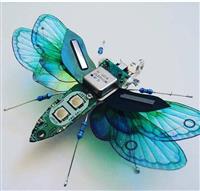
Hi experts,
I have made a few PCBs and used a relatively cheap Chinese reflow oven to solder the surface mount components. I have done boards up to 100x100mm previously without any problem. But one of my latest designs seems to fail whilst in the oven. After the initial failure I asked the board house whether there was any issues with the batch that I had received, but their replay was that it was 5 months since receiving them and they suspected water ingress into the board causing the failure (The black board in the image - tested bare after a failed populated board). I tweaked the design a little and had the PCB remade using a different board house. The failure mode in the oven is pretty much exactly the same. (Red board in photo).
It appears that the board is getting locally too hot in the oven. The area that fails is near the back of the oven, and part way through the heating cycle there is a bad smell and when the oven is opened I have a blistered board and oozed burnt board innards.
Given that this has failed on 2 boards from different PCB manufacturers it must be to do with either my design or the oven. The only thing I can think about the design is that I haven't put a ground plane on either side of the board in this design. A ground plane would at least spread the heat more evenly across the board and may stop this localised burning. I have tried running a cycle of the oven with a thermocouple placed in through the draw and it seems to reflect the temperature expected in the profile, but it is possible that there is an exposed element close to the back of the oven.
Any ideas on this?
Thanks
- Comments(1)
A****min
Jun 15.2019, 09:09:48
Water absorption is a REAL problem, but it will NOT cause burning. it can cause blistering of the substrate or bubbling of large copper areas. A bake out at 50 C for one hour before stuffing and reflow will generally solve that problem.
But, you black board really looks like the temperature control failed, and the board got SEVERELY overheated. I have a setup that requires a thermocouple to be poked into a plated-through hole in the board. One time I forgot to place the thermocouple, and the boards caught fire, and looked a bit worse than your black one.
It appears both boards had an uneven temperature across the boards. The tops (as in the picture) got much hotter than the bottoms.
I use a toaster oven with thermocouple controller, and the only way to get proper temperature control is to have the thermocouple touching the board. With the thermocouple in the air, it can read 100 C or more BELOW the actual board temperature.


